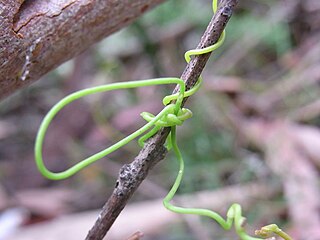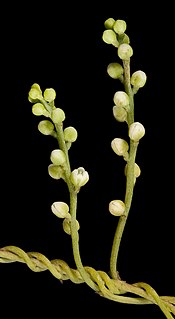
The flowering plant family Lauraceae, the laurels, includes the true laurel and its closest relatives. This family comprises about 2850 known species in about 45 genera worldwide. They are dicotyledons, and occur mainly in warm temperate and tropical regions, especially Southeast Asia and South America. Many are aromatic evergreen trees or shrubs, but some, such as Sassafras, are deciduous, or include both deciduous and evergreen trees and shrubs, especially in tropical and temperate climates. The genus Cassytha is unique in the Lauraceae in that its members are parasitic vines.

Cassytha is a genus of some two dozen species of obligately parasitic vines in the family Lauraceae. Superficially, and in some aspects of their ecology, they closely resemble plants in the unrelated genus Cuscuta, the dodders. When fruit and flowers are absent in the field, the physical resemblance is so close that few people without technical training can tell them apart. In this respect and in their ecology the two genera present a spectacular example of convergent evolution. Nonetheless, Nickrent comments that "Cassytha is uneqivocally assigned to Lauraceae based on (both) morphological and molecular data." In its divergence from habits typical of the Lauraceae, Cassytha also presents examples of mosaic evolution

Vahanga is a small uninhabited atoll part of the Acteon Group in the Tuamotu archipelago, French Polynesia and belongs to the municipality of the Gambier Islands.

Aporphine is an alkaloid with the chemical formula C17H17N. It is the core chemical substructure of the aporphine alkaloids, a subclass of quinoline alkaloids. It can exist in either of two enantiomeric forms, (R)-aporphine and (S)-aporphine.
The name Love vine is variously applied to:

In epidemiology, a disease vector is any living agent that carries and transmits an infectious pathogen to another living organism; agents regarded as vectors are organisms, such as parasites or microbes. The first major discovery of a disease vector came from Ronald Ross in 1897, who discovered the malaria pathogen when he dissected a mosquito.
Zetona is a genus of butterflies in the family Lycaenidae. The single member of this genus, Zetona delospila, the clear-spotted blue or satin blue, is found in Australia in the northern part of the state of Western Australia, the northern parts of the Northern Territory and Queensland.

Cassytha melantha is a parasitic vine. Common names include coarse dodder-laurel and large dodder-laurel. The fruits are about 10–15 millimetres (0.39–0.59 in) in diameter and are green, drying to black. These are edible and are harvested in the wild.

Eucyclodes is a genus of moths in the family Geometridae. According to Catalogue of Life recent revision, only E. buprestaria is included to the genus. Other species are categorized into Chloromachia.

Eucyclodes gavissima, the Oriental orange banded green geometer moth, is a species of moth of the family Geometridae described by Francis Walker in 1861. It is found in the Indian subregion, Sri Lanka, Bhutan, western China, Taiwan, Vietnam, Sumatra and Borneo.

Cassytha pubescens is a native Australian hemiparasitic vine species, in the Laurel family. Common names for the species include devils twine, dodder-laurel, spilled devil’s twine, snotty gobble or downy dodder-laurel. It is a widespread and common species in south eastern Australia. The species was first formally described in 1810 by the Scottish botanist Robert Brown in Prodromus Flora Novae Hollandiae et Insulae Van Diemen. Leaves are reduced to scales and photosynthesis is achieved through chlorophyll contained in the plants stems. Stems are between 0.5mm and 1.5mm in diameter and the haustoria are between 2 and 3 mm long.

Candalides acasta, the blotched blue, is a species of butterfly of the family Lycaenidae. It is found in southern Australia, including Queensland, New South Wales, Victoria, Tasmania, South Australia and Western Australia.

Candalides hyacinthina, the varied dusky-blue, is a species of butterfly of the family Lycaenidae. It is found along the east coast of Australia, including South Australia, New South Wales, Western Australia and Victoria.

Candalides erinus, the small dusky-blue, is a species of butterfly of the family Lycaenidae. It is found in Australia and Indonesia.

Cassytha glabella, commonly known as the slender devil's twine, is a common twining plant of the Laurel family, found in many of the moister parts of Australia. A hemi-parasitic climber. The specific epithet glabella is from Latin, referring to the lack of hairs. The fruit are sweet and mucousy to taste. The Devil's Twine and Cassytha melantha are similar, but with thicker hairier stems.

Cassytha filiformis, common name love-vine, is a species of obligate parasitic vine in the family Lauraceae. The species has a native pantropical distribution encompassing the Americas, Indomalaya, Australasia, Polynesia and tropical Africa In the Caribbean region, it is one of several plants known as "Love vine" because it has a reputation as an aphrodisiac.
Eucyclodes divapala is a moth of the family Geometridae first described by Francis Walker in 1861. It is found in Sri Lanka, as well as Taiwan.

Eucyclodes semialba is a moth of the family Geometridae first described by Francis Walker in 1861. It is found in Sri Lanka, the north-east Himalayas of India, Myanmar and Sundaland.
The anthophytes are a grouping of plant taxa bearing flower-like reproductive structures. They were formerly thought to be a clade comprising plants bearing flower-like structures. The group contained the angiosperms - the extant flowering plants, such as roses and grasses - as well as the Gnetales and the extinct Bennettitales.

Cassytha racemosa is a parasitic perennial in the Lauraceae family. It is found in Western Australia.
















